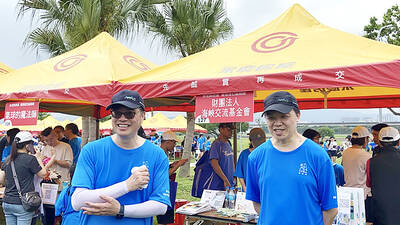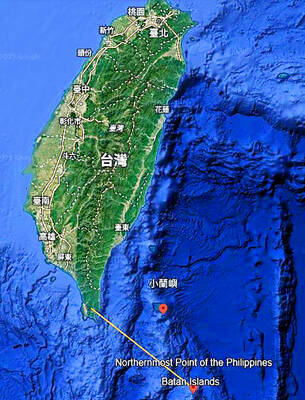Japan yesterday warned China that its extensive land reclamation in the disputed South China Sea does not make ownership “a done deal,” after Beijing announced it had almost finished its controversial island-building.
The rebuke came after Washington urged China against militarization of the area, saying it risked escalating tensions, even as satellite pictures have shown a runway long enough to let even the biggest aircraft land.
It also came as details emerged of a joint exercise between Japan and the Philippines, as the relationship blossoms between the two nations most prepared to push back against Beijing’s perceived rising aggression.
“We hold serious and significant concerns about the unilateral actions aimed at changing the status quo, which are bound to increase tension,” Japanese Chief Cabinet Secretary Yoshihide Suga told reporters.
“With the completion of the reclamation, we must not accept the land reclamation as a done deal. We demand [China] not take unilateral actions that bring irreversible and physical changes,” he added.
Responding to the comments, Beijing countered that “it makes no sense” for Japan to press China on the issue.
“China has indisputable sovereignty over the Nansha Islands [南沙群島] and we do not need to prove this by building facilities on the islands and reefs,” Chinese Ministry of Foreign Affairs spokesman Lu Kang (陸慷) told a regular press briefing, using the Chinese name for the Spratly Islands in the South China Sea.
Japan has long criticized China’s attempts to change the status quo unilaterally and by force, mindful of its own dispute with Beijing over islands in the East China Sea.
The US says China has created 800 hectares of new land in the South China Sea in the past 18 months.
Manila yesterday said that a 3km runway on Fiery Cross Reef (Yongshu Reef, 永暑礁) — big enough to handle a Boeing 747 — was “75 percent complete”.
“This can serve as China’s forward operating base, a refueling stop for ships and aircraft,” Philippine Department of Defense spokesman Peter Galvez said.
“This will allow China easy reach in the West Philippine Sea [the Filipino name for a section of the South China Sea claimed by Manila] and extend their reach up to Australia and other parts of the South Pacific,” Galvez said.
“They can do anything they want there. It could be their command and control center,” he added.
Beijing claims almost all the South China Sea, despite a number of overlapping territorial claims by Taiwan, the Philippines, Vietnam, Malaysia and Brunei.
Beijing yesterday also rolled out more details of the building work it is undertaking in the disputed South China Sea, listing lighthouses, communications stations and other facilities for civilian and emergency use.
The country’s top planning agency, the National Development and Reform Commission, said in a short statement it had drawn up a plan for the use of civil facilities on the Spratly Islands.
These facilities would help improve living conditions there and also fulfil China’s international obligations on environmental monitoring, disaster relief and navigational safety, the commission said.
Large lighthouses for navigation are included in the building plan, along with base stations for wireless navigation equipment, weather stations to monitor tsunamis, scientific research stations and equipment to tackle oil spills, it added.

SECURITY: As China is ‘reshaping’ Hong Kong’s population, Taiwan must raise the eligibility threshold for applications from Hong Kongers, Chiu Chui-cheng said When Hong Kong and Macau citizens apply for residency in Taiwan, it would be under a new category that includes a “national security observation period,” Mainland Affairs Council (MAC) Minister Chiu Chui-cheng (邱垂正) said yesterday. President William Lai (賴清德) on March 13 announced 17 strategies to counter China’s aggression toward Taiwan, including incorporating national security considerations into the review process for residency applications from Hong Kong and Macau citizens. The situation in Hong Kong is constantly changing, Chiu said to media yesterday on the sidelines of the Taipei Technology Run hosted by the Taipei Neihu Technology Park Development Association. With

CARROT AND STICK: While unrelenting in its military threats, China attracted nearly 40,000 Taiwanese to over 400 business events last year Nearly 40,000 Taiwanese last year joined industry events in China, such as conferences and trade fairs, supported by the Chinese government, a study showed yesterday, as Beijing ramps up a charm offensive toward Taipei alongside military pressure. China has long taken a carrot-and-stick approach to Taiwan, threatening it with the prospect of military action while reaching out to those it believes are amenable to Beijing’s point of view. Taiwanese security officials are wary of what they see as Beijing’s influence campaigns to sway public opinion after Taipei and Beijing gradually resumed travel links halted by the COVID-19 pandemic, but the scale of

A US Marine Corps regiment equipped with Naval Strike Missiles (NSM) is set to participate in the upcoming Balikatan 25 exercise in the Luzon Strait, marking the system’s first-ever deployment in the Philippines. US and Philippine officials have separately confirmed that the Navy Marine Expeditionary Ship Interdiction System (NMESIS) — the mobile launch platform for the Naval Strike Missile — would take part in the joint exercise. The missiles are being deployed to “a strategic first island chain chokepoint” in the waters between Taiwan proper and the Philippines, US-based Naval News reported. “The Luzon Strait and Bashi Channel represent a critical access

Pope Francis is be laid to rest on Saturday after lying in state for three days in St Peter’s Basilica, where the faithful are expected to flock to pay their respects to history’s first Latin American pontiff. The cardinals met yesterday in the Vatican’s synod hall to chart the next steps before a conclave begins to choose Francis’ successor, as condolences poured in from around the world. According to current norms, the conclave must begin between May 5 and 10. The cardinals set the funeral for Saturday at 10am in St Peter’s Square, to be celebrated by the dean of the College